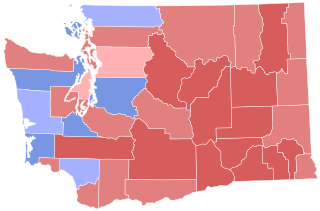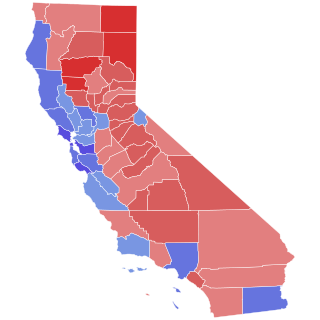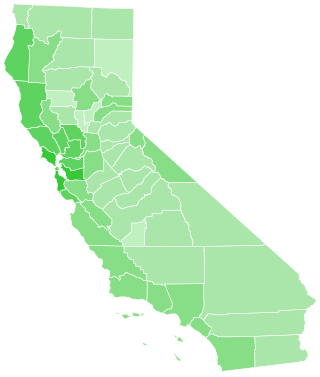Related Research Articles

The two-round system (TRS), also known as runoff voting, second ballot, or ballotage, is a voting method used to elect a single candidate, where voters cast a single vote for their preferred candidate. It generally ensures a majoritarian result, not a simple-plurality result as under first past the post. Under the two-round election system, the election process usually proceeds to a second round only if in the first round no candidate received a simple majority of votes cast, or some other lower prescribed percentage. Under the two-round system, usually only the two candidates who received the most votes in the first round, or only those candidates who received above a prescribed proportion of the votes, are candidates in the second round. Other candidates are excluded from the second round.
Primary elections, or direct primary are voting processes by which voters can indicate their preference for their party's candidate, or a candidate in general, in an upcoming general election, local election, or by-election. Depending on the country and administrative divisions within the country, voters might consist of the general public in what is called an open primary, or solely the members of a political party in what is called a closed primary. In addition to these, there are other variants on primaries that are used by many countries holding elections throughout the world.

The 2004 Washington gubernatorial election was held on November 2, 2004. The race gained national attention for its legal twists and extremely close finish, among the closest political races in United States election history. Republican Dino Rossi was declared the winner in the initial automated count and again in a subsequent automated recount, but after a second recount done by hand, Democrat Christine Gregoire took the lead by a margin of 129 votes.

Elections in Chile are held nationwide, including the presidency, parliament, regional offices, and municipal positions. Chilean citizens and foreign residents with legal residency of at least five years, who are 18 years or older on election day, are eligible to vote. Previously, voting was voluntary, but since 2023, it has become compulsory.

In the politics of the United States, elections are held for government officials at the federal, state, and local levels. At the federal level, the nation's head of state, the president, is elected indirectly by the people of each state, through an Electoral College. Today, these electors almost always vote with the popular vote of their state. All members of the federal legislature, the Congress, are directly elected by the people of each state. There are many elected offices at state level, each state having at least an elective governor and legislature. There are also elected offices at the local level, in counties, cities, towns, townships, boroughs, and villages; as well as for special districts and school districts which may transcend county and municipal boundaries.
California Democratic Party v. Jones, 530 U.S. 567 (2000), was a case in which the United States Supreme Court held that California's blanket primary violates a political party's First Amendment freedom of association.
An open primary is a primary election that does not require voters to be affiliated with a political party in order to vote for partisan candidates. In a traditional open primary, voters may select one party's ballot and vote for that party's nomination. As in a closed primary, the highest voted candidate in each party then proceeds to the general election. In a nonpartisan blanket primary, all candidates appear on the same ballot and the two highest voted candidates proceed to the runoff election, regardless of party affiliation. The constitutionality of this system was affirmed by the Supreme Court of the United States in Washington State Grange v. Washington State Republican Party in 2008, whereas a partisan blanket primary was previously ruled to be unconstitutional in 2000. The arguments for open primaries are that voters can make independent choices, building consensus that the electoral process is not splintered or undermined by the presence of multiple political parties.
A nonpartisan blanket primary is a primary election in which all candidates for the same elected office run against each other at once, regardless of the political party. Partisan elections are, on the other hand, segregated by political party. Nonpartisan blanket primaries are slightly different from most other elections systems with two-rounds/runoff, aka "jungle primaries" , in a few ways. The first round of a nonpartisan blanket primary is officially the "primary." Round two is the "general election." Round two must be held, even if one candidate receives a majority in the first round.

Elections in California are held to fill various local, state and federal seats. In California, regular elections are held every even year ; however, some seats have terms of office that are longer than two years, so not every seat is on the ballot in every election. Special elections may be held to fill vacancies at other points in time. Recall elections can also be held. Additionally, statewide initiatives, legislative referrals and referendums may be on the ballot.
Louisiana primary is the common term for top-two runoff voting system where all candidates for the same office appear together on the ballot in the general election, and if none win a simple majority, a runoff or second round election for the two top candidates is held a short time later to determine the winner.

Ballot Measure 65 was an initiated state statute ballot measure for the November 4, 2008 general election ballot in the state of Oregon. If it had passed, it would have replaced the current closed primary election system for partisan offices, in which each political party nominates its own candidate for the general election. The system proposed by Measure 65 bore similarities to a blanket primary and nonpartisan blanket primary.

Initiative 872 was a 2004 ballot initiative that replaced the open primary being used in Washington state with a top-two nonpartisan blanket primary. It was challenged in court up to the US Supreme Court, which upheld the top-two primary in Washington State Grange v. Washington State Republican Party.

Proposition 14 is a California ballot proposition that appeared on the ballot during the June 2010 state elections. It was a constitutional amendment that effectively transformed California's non-presidential elections from first-past-the-post to a nonpartisan blanket primary. The proposition was legislatively referred to voters by the State Legislature and approved by 54% of the voters. It consolidated all primary elections for a particular office into an election with one ballot that would be identical to all voters, regardless of their party preferences. The two candidates with the most votes in the primary election would then be the only candidates who would run in the general election, regardless of their party affiliation.

The 2014 California Secretary of State election was held on November 4, 2014, to elect the secretary of state of California. Incumbent Democratic secretary of state Debra Bowen was term-limited and ineligible to run for re-election to a third term in office.

The 2014 California State Treasurer election was held on November 4, 2014, to elect the State Treasurer of California. Incumbent Democratic Treasurer Bill Lockyer was term-limited and ineligible to run for re-election to a third term in office.

The 2014 California Insurance Commissioner election was held on November 4, 2014, to elect the Insurance Commissioner of California. Incumbent Democratic Commissioner Dave Jones ran for re-election to a second term in office.

California state elections in 2016 were held on Tuesday, November 8, 2016, with the primary elections being held on June 7, 2016. In addition to the U.S. presidential race, California voters elected one member to the United States Senate, all of California's seats to the House of Representatives, all of the seats of the State Assembly, and all odd-numbered seats of the State Senate.

Alaska Measure 2 was a ballot initiative approved by voters in Alaska as part of the 2020 United States elections. The proposal switched Alaska's primary system to a non-partisan blanket primary. The top four candidates progress to the general election, which is conducted with ranked-choice voting. Voting for U.S. president will continue to utilize primaries based on political party, but ranked-choice voting will still be used in the general election. The initiative also requires additional disclosures of campaign financing.

The 2022 California Superintendent of Public Instruction election was held on June 7, 2022 to elect the Superintendent of Public Instruction of California. Unlike most other elections in the state, the office is not elected under the state's nonpartisan blanket primary system. Instead, the officially nonpartisan position is elected via a general election, with a runoff scheduled for November 8, 2022 as no candidate received a majority of the vote.
A top-four primary or top-four ranked-choice voting is an election method using a nonpartisan blanket primary where up to four candidates, those with the most votes, advance from a first round of voting, regardless of the political party. The round two (general) election, held some weeks later, uses instant-runoff voting to confirm a majority winner among the top set of candidates.
References
- ↑ David Hodari (October 23, 2015). "Argentina elections 2015: a guide to the parties, polls and electoral system". The Guardian . Retrieved November 3, 2015.
- ↑ "La reforma política dejó fuera de competencia a 149 partidos" [The political amendment left out 149 parties]. Clarín (in Spanish). January 25, 2011. Retrieved 11 August 2015.
- ↑ "Los principales puntos (28 October 2009)". Clarín (in Spanish). 28 October 2009. Retrieved 6 November 2010.
- ↑ "Fuerte rechazo de la oposición al proyecto oficialista de reforma". Clarín (in Spanish). 28 October 2009. Retrieved 6 November 2010.
- ↑ "Washington State Grange v. Washington State Republican Party et al" (PDF). March 18, 2008.